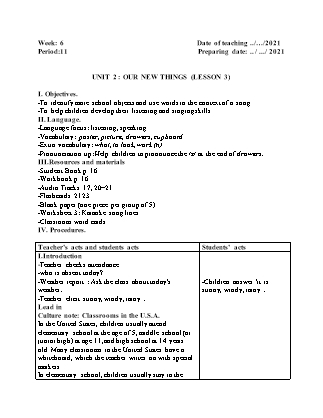Giáo án Tiếng Anh 4 - Unit 2: Our new things - Lesson 3

I. Objectives.
-To identify more school objects and use words in the context of a song
-To help children develop their listening and singing skills
II. Language.
-Language focus: listening, speaking
-Vocabulary: poster, picture, drawers, cupboard
-Extra vocabulary: what, to look, work (n)
-Pronunciation tip: Help children to pronounce the /z/ at the end of drawers.
III.Resources and materials
-Student Book p. 16
-Workbook p. 16
-Audio Tracks 17, 20–21
-Flashcards 2123
-Blank paper (one piece per group of 5)
-Worksheet 3: Karaoke song lines
-Classroom word cards
Bạn đang xem tài liệu "Giáo án Tiếng Anh 4 - Unit 2: Our new things - Lesson 3", để tải tài liệu gốc về máy bạn click vào nút DOWNLOAD ở trên
Week: 6 Date of teaching ../ /2021 Period:11 Preparing date: .. / .../ 2021 UNIT 2 : OUR NEW THINGS (LESSON 3) I. Objectives. -To identify more school objects and use words in the context of a song -To help children develop their listening and singing skills II. Language. -Language focus: listening, speaking -Vocabulary: poster, picture, drawers, cupboard -Extra vocabulary: what, to look, work (n) -Pronunciation tip: Help children to pronounce the /z/ at the end of drawers. III.Resources and materials -Student Book p. 16 -Workbook p. 16 -Audio Tracks 17, 20–21 -Flashcards 2123 -Blank paper (one piece per group of 5) -Worksheet 3: Karaoke song lines -Classroom word cards IV. Procedures. Teacher’s acts and students acts Students’ acts I.Introduction -Teacher checks attendance -who is absent today? -Weather report : Ask the class about today's weather. -Teacher elicit sunny, windy, rainy . Lead in Culture note: Classrooms in the U.S.A. In the United States, children usually attend elementary school at the age of 5, middle school (or junior high) at age 11,and high school at 14 years old. Many classrooms in the United States have a whiteboard, which the teacher writes on with special markers. In elementary school, children usually stay in the same classroom with the same teacher for all of their classes. They each have a drawer or a desk to keep their work in and there is usually a row of coat hooks in the classroom or hallway for them to hang their bags and coats on. In middle school and high school, children go to a different classroom with a different teacher for each subject. They usually have a locker to put their books in at the beginning of the day; they can then take out the books they need before each class and take them to the classroom. What’s the picture? -Do the chant from p. 14 (Track 17) to warm up and energize the class. -Invite a child to come to the front of the class and draw one of the objects from the chant. -The child draws the picture on the board for the rest of the class to guess what it is. -The first child to guess the object correctly comes to the front to draw a second picture. -Divide the class into groups of five and tell them to repeat the activity, using a piece of blank paper. -Use Flashcards to introduce the new vocabulary. Hold up the cards one at a time and say the words for children to repeat. Point to real items in the classroom if possible. -Hold the cards up or point to the items in a different order for children to repeat again. II.Presentation Listen, point, and repeat. (Exercise 1) -Ask children to look at the pictures in their Student Books. Play the first part of the recording (Track 20) for children to point to the words. -Play the second part of the recording for children to repeat the words. -Play the recording all the way through again for children to listen and point and then repeat. -Hold up Flashcards one at a time for individual children to say the words. Listen and sing. (Exercise 2) -Ask children to look at the picture. Point to the different things and ask What’s this? Ask children to predict what the song is about (a classroom). -Play the song all the way through once for children to listen; then play it again as they follow the words in their books. -Play it again, stopping after each line for children to repeat. -Play the recording for children to sing along. Sing and do. (Exercise 3) -Ask children to look at the pictures and decide together what the actions should be for this song. -Practice the actions with the class. -Play the recording (Track 21) for children to sing the song and do the actions. IV.Development Worksheet 3: Karaoke song lines -Make sure children have their books closed. -Cut out the song words (below) and give out to groups of three to four children in a jumbled order. -Ask the groups to try to remember the song and put the words in the correct order. -Play Track 21 again while children check their sentence order and make changes if necessary. Play it more than once if necessary. V.Consolidation Exercises: Workbook p. 16 -Children answer ‘it is sunny, windy, rainy . Coat hook Computer Table Pencil case Board Poster Picture Drawers Listen and point. poster, picture, drawers drawers, poster, picture Listen and repeat. poster, picture, drawers What’s this?(in the picture of the song) . . Song actions What’s in the classroom? – raise hands as if asking a question Verse 1 – point to posters and pictures on the wall and mime opening a book Verse 2 – mime opening a drawer, and then point to the board Verse 3 – point to door and a window, and then a table and chair
Tài liệu đính kèm:
 giao_an_tieng_anh_4_unit_2_our_new_things_lesson_3.docx
giao_an_tieng_anh_4_unit_2_our_new_things_lesson_3.docx



